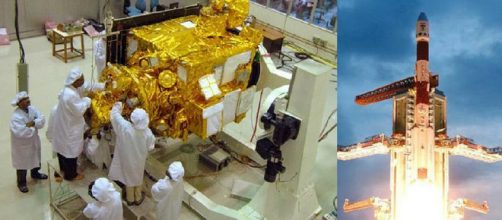In what could be the first unprecedented moon landing of its kind in history, India’s space agency ISRO (Indian Space Research Organisation) is planning to send a lunar probe to the Moon's South Pole which till today remains an unchartered region territory of the lunar surface. The vehicle named Chandrayaan -2 is scheduled for lift-off in April this year and if successful will become the first lunar probe to land in the region of the moon's South Pole where others have all landed near the equator.
The ambitious project to be launched by the ISRO comes in the wake of the first unsuccessful Chandrayaan -1 which was launched in 2008 and terminated after scientists lost contact with the spacecraft.
A major breakthrough if successful: targeted area has rocks four billion years old
This mission would be a scientific milestone and a breakthrough of sorts in lunar exploration as the area that has been targeted for landing consists of rocks that are regarded by scientists to be four billion years old. By that, one can imagine the sheer magnitude of the data and research the project would yield. It would become a goldmine of information to which scientists have not yet been privy too as no craft has attempted such a challenge till date.
ISRO’s ambitious project is being touted as a daredevil manoeuvre as the first-ever mission to soft-land on the moon's South Pole. The mission itself is not without its technical challenges.
Said former ISRO chief AS Kiran Kumar on Saturday, Feb 4 “We have identified two locations and will be choosing one. No other moon mission has landed in this area.” Incidentally, AS Kiran Kumar retired just last month.
Landing simulations are underway: scheduled launch in April
Speaking to the Times of India, current ISRO chairman K Sivan said that Chandraayan-2 will be a real challenge because this is going to be the first instance a lander, orbiter and a rover will be carried to the moon.
Even now, landing simulations are also underway at ISRO’s Liquid Propulsion System Center at Mahindra Giri in Tamil Nadu. A prototype of the lander will attempt a simulated soft-landing from a height of approximately 80 meters.
Technology and hardware almost ready
The ISRO chief also revealed the technology and hardware for Chandrayaan -2 was almost ready and launch is scheduled by the first quarter or second half of 2018. Chandrayaan-2 will be carried into the lunar orbit by the Geosynchronous Satellite Launch Vehicle Mark II space rocket. Solar energy will be used to power the rover every lunar day which is equivalent to 14 Earth days. It will be analysing the lunar surface and transmitting data and images back to Earth.
The lunar probe may discover water which would be phenomenal
Wu Ji the director of the National Space Science Center in Beijing said it was a challenging and complicated mission because there is less sunlight at the lunar poles so the lunar probe may receive less power.
The project aims to land the probe in an area between the lunar mountain craters of Simpelius N and Manzinus C which are 70 degrees south. This is an entirely unknown area near the lunar South Pole but the scientists working on the project feel it will not just be a milestone in lunar exploration but more ambitiously pave the way for possible lunar habitation in case the probe discovers water.
Will Chandrayaan-2 redeem the loss of Chandrayaan –I. Scientists are optimistic.
The spacecraft carrying the probe weighs 3,300 kg and will be launched from the Sriharikota Satish Dhawan Space Centre located on the country’s southwest coast. The rocket GSLV MKII will launch the spacecraft that will carry the orbiter, robot and lander to the moon.
Upon launch, the spacecraft will enter a 170 x 20, 000 km elliptical orbit. From here, the craft will be manoeuvred towards a lunar orbit with the help of thrusters.
In 2008 Chandrayaan –I was launched from Sriharikota at a cost of $83 million. The main craft made it to the lunar orbit and a lunar probe landed on the moon. It even discovered magmatic water on a moon pit. Unfortunately, the main craft malfunctioned in 2009 crashing into the moon breaking all communications with the probe. The project was subsequently abandoned. In 2017, NASA through its Jet propulsion Lab in Pasadena, California, located the lunar orbiter hovering near the moon’s North Pole.
Scientists are hopeful that Chandrayaan –2 will be successful and put India on the map as one of the latest major contenders in space exploration.


